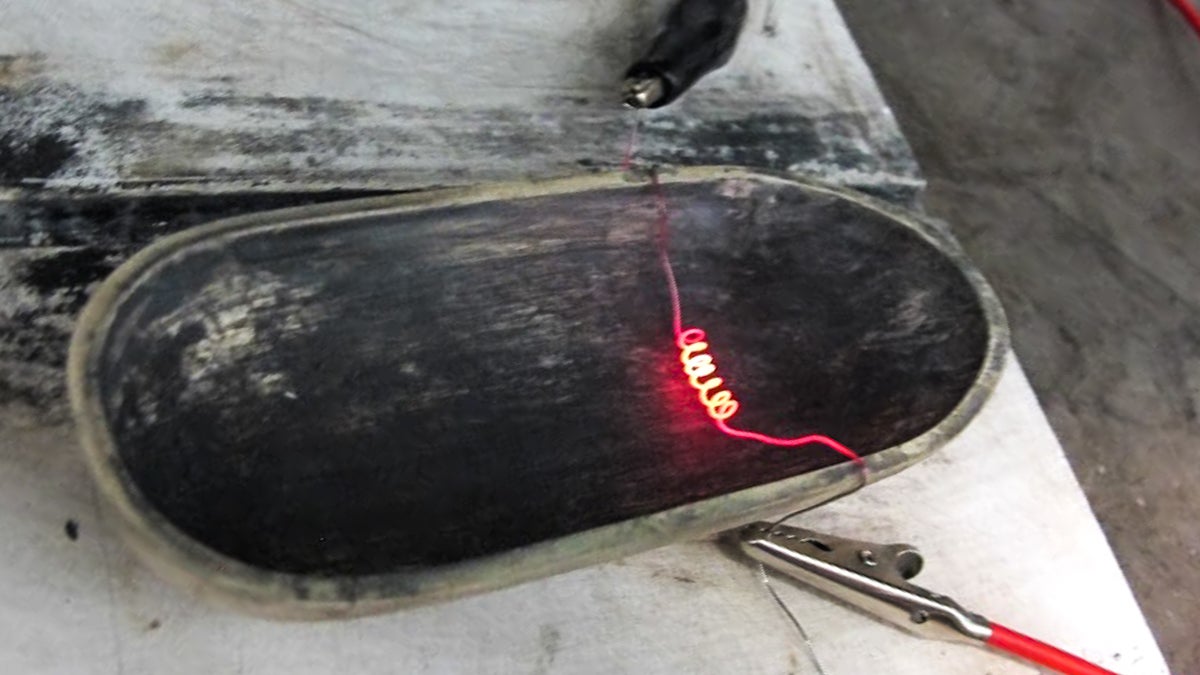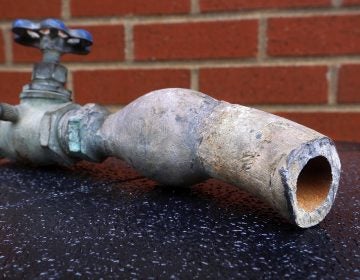Fuel, oxygen, and ignition: the science of fireworks
Listen 4:47
A hot coil in Matt Cline's lab. (Liz Reid/for WHYY)
A childhood pyromaniac grows up, becomes a chemist and makes sparks fly in the lab.
Matt Cline, 43, is a chemical engineering lab instructor at Carnegie Mellon University, and he’s been playing with explosives since he was a kid growing up in the Cincinnati suburbs.
“We were kind of feral kids,” Matt said, laughing. “And certainly there was no kind of helicoptering parents.”
The youngest of four children, Matt had some freedom while his parents were busy dealing with his older siblings. To fill the time, he did odd jobs and reinvested his earnings.
“I would mow lawns in the summer and would take the money that I would earn and go down to the drugstore. And for $1 you could buy a bottle of zinc powder, and for 79 cents, flowers of sulfur, and for $1.29 you could get a bottle of potassium nitrate,” Cline said.
With those three items, he created a mixture that would burn slowly and fill the entire vacant lot behind his house with smoke.
Through his experiments, and with the encouragement of his science teacher, Matt learned the basics of how to make stuff catch fire.
“You have to have a fuel and an oxidizer and a source of ignition,” he said.
For the next step, to make something explode, you just have to house the fire inside of a container.
By the time he was in eighth grade, Matt was making small explosives in a supervised way at school, and making homemade rockets in an unsupervised way out of school.
“If you can make rockets on your own and you have some ability to make things blow up a little bit, you’re most of the way towards thinking about making fireworks,” Cline said. “I want to shoot this thing up, and I’m going to get it to blow up and hopefully make color.”
The anatomy of a firework is fairly simple. The main component is a ball, maybe six inches in diameter. The outer shell is made of something that catches fire easily, like paper.
To create that starburst look, the outer ball is packed with smaller components called stars, each designed to burn with a certain color and brightness.
“I’ll arrange them and structure them in a way such that when they go up and explode they’re going to be distributed in the sky a certain way,” said Cline.
Different chemicals serve different purposes. Some are there just to provide oxygen. Some act as fuel. Some do both. Other chemicals make colors. Strontium nitrate makes things burn red. Copper burns blue. Once assembled, you put the ball of chemical materials into a mortar, which is a tube to shoot it out of.
“You launch the thing up into the sky, and you have to have fuses or some sort of time delay that is burning the whole time,” Cline said.
When the fuse burns down, the firework explodes, sending those little flaming balls out into the sky.
When Cline was a freshman in high school, he and a friend accidentally exploded a metal carbon dioxide cartridge, sending shrapnel into his stomach, hands, and head.
“When I came out of surgery and my dad had arrived at the hospital … he had a pack of sparklers, like little toy sparklers,” Cline said. “And basically what he told me was, ‘Don’t play with anything more dangerous than this until you really know what you’re doing.’ And that got me started down a path of chemistry.”
Though he doesn’t build explosives at home anymore, Cline does have a stash of explosive materials in the lab at Carnegie Mellon. On a recent morning, he did a few demonstrations for me in the lab. He climbed up onto a chair and started rummaging around in a high cabinet to gather his materials.
These days it’s “safety first,” so Cline set everything up behind a protective chemistry hood, and we both put on plastic safety glasses.
He grabbed the flash powder, which is pretty much the same mixture he was making with drug store ingredients back in eighth grade. Cline spooned a small amount on top of a metal coil, then turned on the power supply to heat up the coil.
After a couple of seconds, the coil got hot enough to set the flash powder on fire. There’s a quick crackling noise, and white light filled the dark room for a fraction of a second, eventually fading to reveal a small fire that burned for another second longer.
“Did you see that red color? The red color and the sparkliness? That’s the strontium nitrate that’s giving that red. If we did not have that salt in there, we would have no red color,” said Cline.
Next, we tried gunpowder, which burned up much more quickly.
“Nice,” said Cline, grinning. “That little ‘fwump’ noise, I never get tired of that.”
WHYY is your source for fact-based, in-depth journalism and information. As a nonprofit organization, we rely on financial support from readers like you. Please give today.






